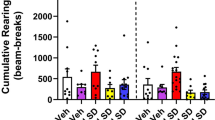Abstract
The effects of antimanic agents, including lithium, carbamazepine, clonazepam and zotepine, on the postsynaptic 5-HT1A receptor-mediated behavioral and hypothermic responses induced by 8-OH-DPAT in rats, and on [3H]8-OH-DPAT binding to 5-HT1A receptors in the rat hippocampus were examined. Treatment with lithium (3 mEq/kg, IP) for 14 days enhanced forepaw treading, one component of the 5-HT behavioral syndrome induced by 8-OH-DPAT, and this enhancement by lithium was abolished by catecholamine depletion with reserpine or α-methyl-p-tyrosine, but not by 5-HT depletion withp-chlorophenylalanine. These data suggest that lithium enhances 5-HT1A-mediated behavior via catecholaminergic systems. In contrast, chronic lithium treatment did not alter the hypothermic response to 8-OH-DPAT in untreated rats, as well as in rats treated with reserpine. These findings strengthen the suggestion that lithium has no direct influence on the postsynaptic 5-HT1A-mediated response. Other antimanic agents had no effect on either forepaw treading or hypothermia induced by 8-OH-DPAT. Radioligand binding studies using [3H]-8-OH-DPAT demonstrated that chronic lithium treatment, but not other antimanic agents, caused 5-HT1A receptor down-regulation in rat hippocampus. A discrepancy therefore exists between 5-HT1A receptor down-regulation and unaltered 5-HT1A-mediated behavioral and hypothermic responses in catecholamine-depleted rats after chronic lithium treatment.
Similar content being viewed by others
References
Blier P, de Montigny C, Tardif D (1987) Short-term lithium treatment enhances responsiveness of postsynaptic 5-HT1A receptors without altering 5-HT autoreceptor sensitivity: an electrophysiological study in the rat brain. Synapse 1:225–232
Chouinard G, Young SN, Annable L (1983) Antimanic effects of clonazepam. Biol Psychiatry 18:451–466
Cox B, Lee TF (1981) 5-Hydroxytryptamine -induced hypothermia in rats as an in vivo model for the quantitative study of 5-hydroxytryptamine receptors. J Pharmacol Methods 5:43–51
Goodwin GM, Green AR (1985) A behavioural and biochemical study in mice and rats of putative agonists and antagonists for 5-HT1 and 5-HT2 receptors. Br J Pharmacol 84:743–753
Goodwin GM, De Souza, RJ, Wood AJ, Green AR (1986) The enhancement by lithium of the 5-HT1A mediated serotonin syndrome produced by 8-OH-DPAT in the rat: evidence for a post-synaptic mechanism. Psychopharmacology 90:488–493
Goodwin GM, De Souza RJ, Green AR (1987) Attenuation by electroconvulsive shock and antidepressant drugs of the 5-HT1A receptor-mediated hypothermia and serotonin syndrome produced by 8-OH-DPAT in the rat. Psychopharmacology 91:500–505
Gozlan H, Mestikawy SE, Pichat L, Glowinski J, Hamon M (1983) Identification of presynaptic serotonin autoreceptors using a new ligand, [3H]-PAT. Nature 305:140–142
Hamon M, Gozlan H, Bourgoin S, Mestikawy SE, Pichat L (1984) Recent advances in the pharmacology of central serotonergic neurons. Adv Biol Psychiatry 14:12–20
Hjorth S (1985) Hypothermia in the rat induced by the potent serotonergic agent 8-OH-DPAT. J Neural Transm 61:131–135
Hjorth S, Carlsson P, Lindberg D, Sanchez D, Wikström H, Arvidsson L-E, Hacksel U, Nilsson JLG (1982) 8-Hydroxy-2-(di-n-propylamino) tetralin, 8-OH-DPAT, a potent and selective simplified ergot congener with central 5-HT-receptor stimulating activity. J Neural Transm 55:169–188
Hotta I, Yamawaki S (1986) Lithium decrease 5-HT1 receptors but increases 5-HT-sensitive adenylate cyclase activity in rat hippocampus. Biol Psychiatry 21:1382–1390
Hutson PH, Donohoe TP, Curzon G (1987) Hypothermia induced by the putative 5-HT1A agonists LY 165163 and 8-OH-DPAT is not prevented by 5-HT depletion. Eur J Pharmacol 143:221–228
Jacobs BL, Klemfuss H (1975) Brain stem and spinal cord mediation of serotonergic behavioral syndrome. Brain Res 100:450–457
Lowry OH, Rosenbrough NJ, Farr AL, Randall RJ (1951) Protein measurement with the folin phenol reagent. J Biol Chem 193:265–275
Maggi A, Enna SJ (1980) Regional alterations in rat brain neurotransmitter systems following chronic lithium treatment. J Neurochem 34:888–892
Middlemiss DD, Blachborough L, Leather SR (1977) Direct evidence for an interaction ofβ-adrenergic blockers with the 5-HT receptor. Nature 267:289–290
Mizuta T, Segawa T (1988) Chronic effects of imipramine and lithium on postsynaptic 5-HT1A and 5-HT1B sites and on presynpatic 5-HT3 sites in rat brain. 47:107–113
Newman ME, Lerer B (1988) Chronic electroconvulsive shock and desipramine reduce the degree of inhibition by 5-HT and carbachol of forskolin-stimulated adenylate cyclase in rat hippocampal membranes. Eur J Pharmacol 148:257–260
Newman ME, Drummer D, Lerer B (1990) Single and combined effects of despiramine and lithium on serotonergic receptor number and second messenger function in rat brain. J Pharmacol Exp Ther 252:826–831
Nishizono M, Fukui S (1983) New aspect of effect of thiepin derivate, zotepine: the correlation between sedative-antimanic effect and reducing effect on level of serum uric acid. Seishin Igaku (Clinical Psychiatry) 25:295–309
Odagaki Y, Koyama T, Matsubara S, Matsubara R (1990) Effects of chronic lithium treatment on serotonin binding sites in rat brain. J Psychiatry Res 24:271–277
Pandey SC, Isaac L, Davis JM, Pandey GN (1991) Similar effects of treatment with despiramine and electroconvulsive shock on 5-hydroxytryptamine1A receptors in rat brain. Eur J Pharmacol 202:221–225
Schlegel JR, Peroutka SJ (1986) Nucleotide interactions with 5-HT1A binding sites directly labeled by [3H]-8-hydroxy-2-(di-n-propylamino)tetralin ([3H]-8-OH-DPAT). Biochemical Pharmacol 35:1943–1949
Sheard MH, Aghajanian GK (1970) Neuronally activated metabolism of brain serotonin: effect of lithium. Life Sci 9:285–290
Treiser SL, Cascio GS, O'Donohue TL, Thoa NB, Jacobowitz DM, Kellar KJ (1981) Lithium increases serotonin release and decreases serotonin receptors in hippocampus. Science 213:1529–1531
Tricklebank MD, Forler C, Fozard JR (1984) The involvement of subtypes of the 5-HT1 receptor and of catecholaminergic systems in the behavioural response to 8-hydroxy-2-(di-n-propylamino) tetralin in the rat. Eur J Pharmacol 106:271–282
Uchitomi Y, Yamawaki S (1987) Behavioural effects of 8-OH-DPAT, a 5-HT1A agonist in rats and effects on the behaviour of antimanic drugs. Jpn J Psychopharmacol 7:383–392
Wagner HR, Vitali P, Palfreyman MG, Zraika M, Huot S (1982) Simultaneous determination of 3,4-dihydroxyphenylalanine, 5-hydroxytryptophan, dopamine, 4-hydroxy-3-methoxyphenylalanine, norepinephrine, 3,4-dihydroxyphenylacetic acid, homovanillic acid, serotonin and 5-hydroxyindoleacetic acid in rat cerebrospinal fluid and brain by high-performance liquid chromatography with electrochemical detection. J Neurochem 38:1241–1254
Yamawaki S, Yanagawa K, Hotta I, Uchitomi Y (1986) Effect of long-term lithium treatment on serotonin syndrome in rats. Jpn J Psychopharmacol 6:247–252
Author information
Authors and Affiliations
Rights and permissions
About this article
Cite this article
Uchitomi, Y., Yamawaki, S. Chronic lithium treatment enhances the postsynaptic 5-HT1A receptor-mediated 5-HT behavioral syndrome induced by 8-OH-DPAT in rats via catecholaminergic systems. Psychopharmacology 112, 74–79 (1993). https://doi.org/10.1007/BF02247365
Received:
Revised:
Issue Date:
DOI: https://doi.org/10.1007/BF02247365




